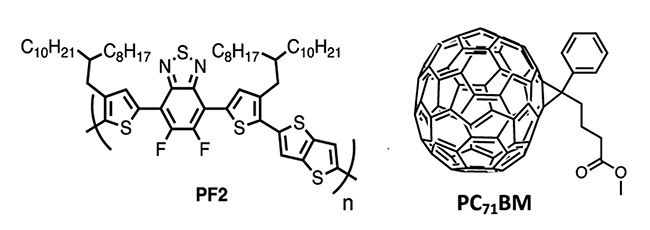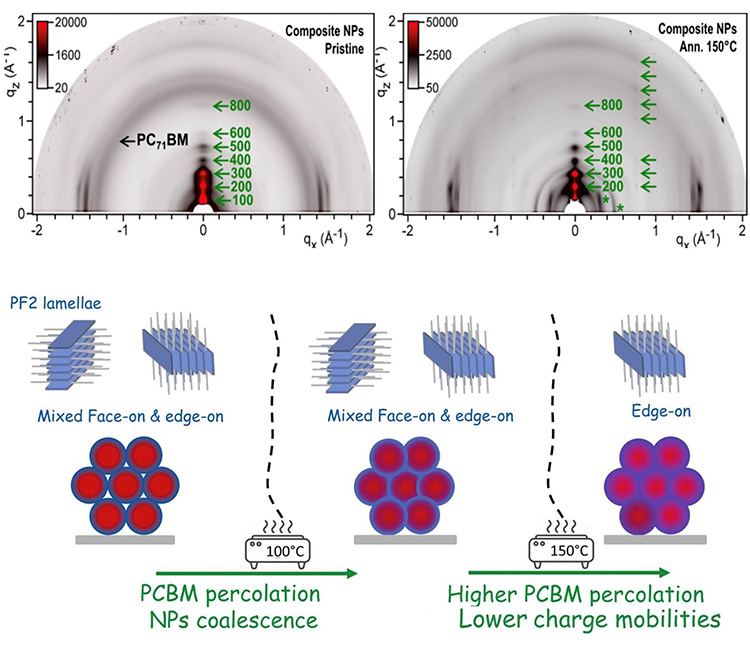Organic photovoltaics (OPVs) are valued for advantages over silicon solar cells, including flexibility, low costs, and light weight. However, halogenated solvents used in their production pose environmental and health issues, hindering commercialization. Scientists from ICPEES (Strasbourg), developed new methods for eco-friendly organic solar cells (OSC) using water-based inks, composed of composite nanoparticles (NPs). Their study used STXM (Scanning Transmission X-ray Microscopy) at HERMES and GIWAXS (Grazing Incidence Wide Angle X-ray Scattering) at SIRIUS to examine morphological changes in NPs.
Organic photovoltaics (OPV) have shown significant improvements over the past decade, making them viable alternatives to traditional silicon solar cells. Despite their impressive efficiencies, OPVs’ need halogenated solvents and high-temperature processing which leads to environmental and health challenges, ultimately limiting their commercialization. This study explores the use of aqueous inks containing dispersions of organic semiconductor nanoparticles (NPs) as an eco-friendly approach. In these OPVs, NPs are composed of both donor (D) and acceptor (A) components, forming D/A heterojunctions with morphologies that facilitate efficient electron transport.
The scientists focused on a fluorinated, low-bandgap polymer known as PF2 [figure 1] for donor, featuring a benzo[2,1,3]thiadiazole unit and long, branched alkyl chains. This polymer’s structure promotes high stacking cohesion, leading to efficient power conversion efficiencies (PCEs). PC71BM fullerene molecule was used as the acceptor component. The poor solubility of PF2 in benign solvent requires a mini-emulsion process for NP formation. Synthesis using this method and control of morphology by thermal annealing is explored in this study that includes various standard laboratory characterization techniques as well as synchrotron-based techniques.

Figure 1: Chemical structure of PF2 (donor) and PC71BM (acceptor)
Characterization by STXM
Surface energy measurements indicated that the fluorinated PF2 should be located in the NP shell, with PC71BM occupying the core. Scanning Transmission X-ray Microscopy (STXM) at the HERMES beamline confirmed this core-shell morphology, showing that prior to annealing, the core consists of ~70 wt% PC71BM, while the shell contains only 25%wt% PC71BM for ~75 wt% PF2. Figure 2 shows an example of thickness and composition map of the NPs without annealing. Post-annealing at 150°C, PC71BM content in the shell rose to 42 wt%. At intermediate temperature of annealing at 100°C the interplay between electron and hole mobilities is favorable and improves the PCE to 1.6%.

Figure 2: STXM images of dialysed PF2:PCBM 1:1 composite NPs. Thickness maps (a, b) and composition maps (c, d) of PF2 (a, c) and PCBM (b, d). Scale bar represents 400 nm.
Characterization by GIWAXS
GIWAXS studies at SIRIUS beamline at SOLEIL and at PLS-II beamline at Pohang Accelerator Laboratory (Korea) examined thin films annealed at different temperatures, correlating structural changes to charge carrier mobilities and PCE. After annealing at high temperature (>100°C), a decrease in the PCE is observed as pristine PF2 was found to be aligned edge-on, improving electron mobility along the substrate plane while slightly reducing hole mobility in the perpendicular direction. For the composite NPs, lamellar periodicity was found in pristine and annealed NPs except the appearance of numerous reflections in the annealed sample that reveal crossing of a phase transformation (figure 3).

Figure 3: GIWAXS patterns of a (PF2:PC71BM) composite NP film, as prepared and after annealing at 150°C, and schematic representation of the morphological changes during annealing.
Results show that a donor-acceptor phase separation leads to a final core-shell structure of the NPs. This ink is then used to print the active layer of the solar cell. After annealing, sintering of the NP with phases reorganization occurs, enhancing electron transport and improving device efficiency.
This research demonstrates that eco-friendly NP synthesis can enable customizable internal morphologies within NPs, particularly under thermal treatment, advancing the prospects for sustainable OPV technologies. Future studies will include the optimization of size/composition of the nanoparticles as well as combination of different donor-acceptor pairs so that higher efficiencies and better morphological control can be achieved. The insights obtained in this work will certainly lead to more sustainable photovoltaic technologies that meet industrial safety and environmental considerations. In this context a common PhD project between SOLEIL and University of Strasbourg is underway.
